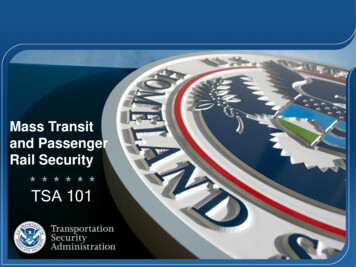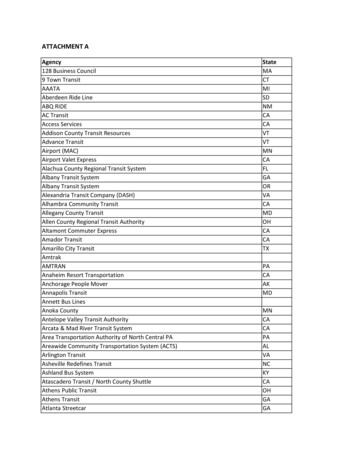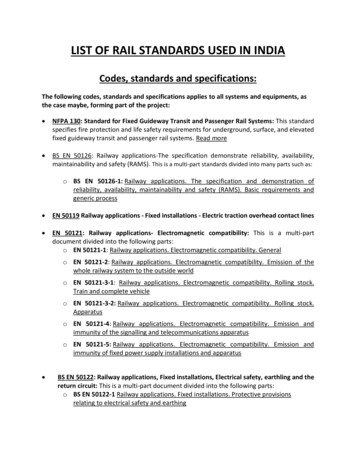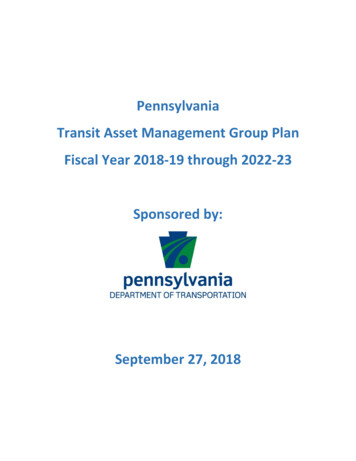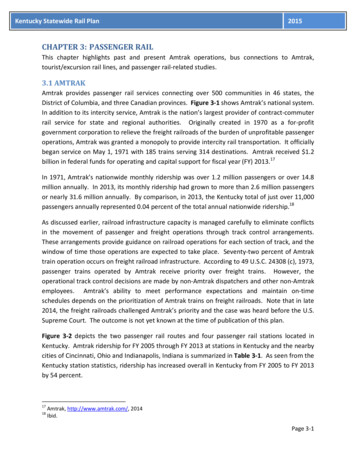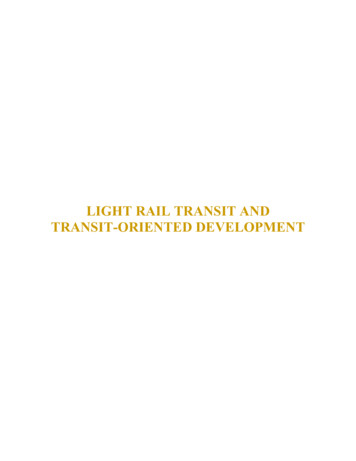
Transcription
LIGHT RAIL TRANSIT ANDTRANSIT-ORIENTED DEVELOPMENT
LIGHT RAIL TRANSIT AND TRANSIT-ORIENTED DEVELOPMENTLight Rail and the American CityState-of-the-Practice for Transit-Oriented DevelopmentG. B. ARRINGTONParsons BrinckerhoffOver the past two decades a growing number of communities have married light rail transit(LRT) and transit-oriented development (TOD) as part of an integrated strategy to revitalizeAmerican cities. Along the way LRT has evolved to become both a people-moving and acommunity-building strategy. The FTA has come to recognize that link in elevating land use asan important consideration for New Starts recommendations. With the competition for federalfunding at an all time high, land use can make a difference in which projects are recommendedfor federal funding. Yet transit-adjacent, not transit-oriented, development remains the norm inmost communities.Capturing the opportunities and benefits of TOD has important implications for theplanning, design, and implementation of LRT systems. The essential elements of a successfulintegrated LRT and TOD strategy—designing development-oriented transit and achievingsupportive public policy—are examined along with the underlying market forces helping to drivea growing demand for transit-friendly compact, urban living. There is a wide diversity of TODimplementation approaches and agencies in a lead role across the country. A snapshot isprovided of TOD implementation experience in Dallas, Texas; Portland, Oregon; Denver,Colorado; and San Jose and San Diego, California. Finally, communities interested in pursuingan integrated LRT and TOD strategy are offered five lessons learned and ten steps to success inplanning for LRT and TOD.Over the past two decades a growing number of communities have pursued LRT andTOD as part of an integrated transportation and land use strategy to help revitalize Americancities. This paper looks at the progress and implications of that journey for the planning, design,funding, and implementation of new LRT systems.The first wave of LRT systems was justified largely on conventional measures—ridership, efficiency, and energy savings. Broader community measures such as economicdevelopment and land use were not allowed as a consideration in the federal funding. To theconsternation of many in the transit industry, the Urban Mass Transportation Administration(UMTA) argued that those “secondary benefits” of transit were “captured in the single roll-upmeasure” of cost effectiveness.Times have changed. UMTA has become FTA, and the New Starts evaluation processhas taken on a new character. Where it was once off the table, FTA now gives specialconsideration to land use in their New Starts evaluation.Subsequent generations of cities interested in implementing LRT systems have learnedfrom the experience of early systems like Portland, Oregon, and San Diego, California. LRT incombination with land use planning can be a powerful tool to help shape growth. Land use isnow playing an increasingly important role in local and federal decision-making for new LRTinvestments.189
190Transportation Research Circular E-C058: 9th National Light Rail Transit ConferenceWHAT IS TOD?Transit-oriented development (TOD) focuses compact growth around transit stops, therebycapitalizing on transit investments by bringing potential riders closer to transit facilities andincreasing ridership. At an individual station TOD can increase ridership by 20% to 40%, and up to5% overall at the regional level (1) (Figure 1).TOD can also produce a variety of other local and regional benefits by encouraging walkablecompact and infill development. Just as importantly, TOD is being embraced by a growing numberof communities as part of a strategy for accommodating growth without diminishing livabilityTOD draws on many of the same planning and development principles embraced by NewUrbanism, Smart Growth, and the Livable Communities Movement: Moderate to high density development in relation to the existing pattern of development;A mix of land uses, horizontally or vertically;Compact pedestrian-oriented design and streetscapes;Building design and orientation to street which allows easy pedestrian and transit access;A fine-grained connected street pattern without cul-de-sacs; andA system of parks and open spaces.By focusing compact growth around transit stops, TOD capitalizes on transit investments bybringing potential riders closer to transit facilities and increasing ridership. TOD can also produce avariety of other local and regional benefits by encouraging walkable compact and infill development.A successful TOD will reinforce both the community and the transit system. TOD has broadpotential in both large and small communities using bus and rail transit systems. Figure 1 illustratesall the basic elements of good TOD design in a development along the Embarcadero line: moderateto higher density, a mix of uses, development at a pedestrian scale and civic spaces. The similarlydesigned Eastside Village station in Plano, Texas, is shown in Figure 2.FIGURE 1 Embarcadero light rail transit, San Francisco, California.
Arrington191FIGURE 2 Eastside Village, Plano, Texas.NEW STARTS AND LAND USEWith national interest in new light rail projects at an all time high, the demand for federalfunding far outstrips the supply. In the scramble for federal funding, land use has become animportant differentiator in determining which projects FTA recommends to Congress. In FTA’sevaluation of projects, land use is second only to the strength of the local financial commitment.In choosing what projects to fund, FTA and Congress are interested in projects that demonstratemerit; they want to see projects receiving federal funding succeed. Current and future land usepatterns are important indicators of that success.A review of the fiscal year 2004 New Starts Report reveals that land use is having amaterial effect—both positive and negative—on how FTA rates the justification of projects.Communities such as Charlotte, North Carolina, have seen their rating improve: “The Mediumproject justification rating reflects the strong transit-supportive land use policies in place tosupport the proposed light rail project.” In communities such as Miami, Florida, land use has hada different impact: “The Medium project justification rating reflects the marginally transitsupportive policies and existing land use along the proposed alignment” (2).FTA’s land use criteria have provided additional motivation at the local level toincorporate TOD early in the planning and design of New Starts projects. In evaluating the landuse potential for a successful New Start transit project, FTA applies eight transit-supportive landuse measurement factors on a sliding scale. The closer the project is to moving into construction,the higher the standard. The significance for projects chasing federal funding is that the bar for ahigh rating will literally be a moving target as the project progresses through the projectdevelopment cycle. The eight land use factors FTA uses to evaluate local projects are:
192Transportation Research Circular E-C058: 9th National Light Rail Transit Conference1.2.3.4.5.6.7.8.Existing land use;Impact of proposed New Starts project on land use;Growth-management policies;Transit-supportive corridor policies;Supportive zoning near transit stations;Tools to implement land use policies;The performance of land use policies; andExisting and planned pedestrian facilities, including access for persons with disabilities.TOD OR TAD: TRANSIT-ORIENTED OR TRANSIT-ADJACENT DEVELOPMENT?To realize the benefits of TOD it is not enough for development to be adjacent to light rail. Thedevelopment must be shaped by transit. Within the family of TOD you might say there are two“brothers”—TOD and his “evil brother,” transit-adjacent development” (TAD). TAD can be definedbroadly as development in close proximity to transit, generally within one-quarter mile. Thedevelopment is close to transit, but not oriented to transit. Unfortunately for light rail transit (LRT) inAmerica there are many more TADs than TODs.Comparatively, in the case of TOD, the projects are also located within a quarter mile of thestation, but the development has been, through public policy or private initiative, partially molded bytransit. The reshaping in relationship to transit might include one or all of the following: A compact site design, oriented for the pedestrian; Higher density and intensity of uses, in relation to the norm for the community; Buildings oriented to transit, (i.e. doors located convenient to a transit stop); Limited parking, the parking supply has been “pinched” or placed in multi-level parkingstructures; and Pedestrian access and high-quality, safe facilities.TOD OVERLAY ZONESOne of the reasons we have more TADs than TODs is that in most of the United States, TOD is“illegal”—illegal in the sense that local development codes and zoning do not allow for the compact,mix of uses, with reduced parking requirements, urban style setback, and side yard requirementstypical of TOD-style development. An essential first step in planning for TOD is to change localplanning codes and ordinances to allow TOD where it is desired.Transit overlay zones are an approach that has been used in a variety of American cities tofurther TOD implementation. In 1978, Dade County, Florida, established a Rapid Transit Zone alongthe entire length of Miami’s heavy-rail system. In San Diego and Los Angeles, California, their TODoverlay is an option developers can use. San Diego’s “floating” Urban Village Overlay Zone allowsdevelopers to apply TOD principles to any site adjacent to a planned or existing light rail station.Both the cities of Phoenix and Tempe, Arizona, have developed TOD overlay zones for theirproposed Valley Metro LRT line. The City of Mountain View, California, has likewise established acombination floating-overlay zone called the Transit District, or “T” Zone. Use of this designation is
Arrington193restricted to properties currently zoned for either industrial or commercial and that lie within 2000 ftof a rail-transit station (3).Portland, Oregon, and Seattle, Washington, have taken a different tactic and used the overlayto replace underlying zoning. In Portland, the city has instituted an overlay zone called the Light RailTransit Zone. This designation increases permitted densities, restricts auto-oriented uses, andencourages pedestrian-oriented development in LRT station areas, including small retail shops,restaurants, outdoor cafes, benches, and kiosks.DETAILED STATION AREA PLANSLRT communities have come to learn that “build it and they will come” is a theory that has notplayed out in reality without supportive public policy. For the areas up to .25 to .50 mi aroundproposed LRT stations, detailed station area plans have become a popular way to help leverage thedevelopment potential of TOD. Station area plans can offer both the neighborhoods and thedevelopment community certainty and predictability. The planning is typically funded as an activityeligible for federal funding as part of the transit investment, just like the engineering of the line.Communities that have undertaken detailed station area plans for LRT include San Diego andSacramento, California, Minneapolis, Minnesota, Portland, and the San Francisco Bay Area. SanJose has successfully used the Planned Unit Development designation to shape the location anddesign of several TODs near its light rail system stations, such as the Almaden Lake Village. Anexample of the use of Specific Plans to implement TOD policies comes from Mountain View. Called“Precise Plans” by the city, the Whisman Station Precise Plan introduced land-use and designstandards for properties near this Silicon Valley light-rail stop (4).A detailed station area-planning program typically involves a detailed assessment of the areaup to .25 to .50 mi around each station area resulting in: programs.The preparation and local adoption of a station area plan including a vision;A land use plan map of future land uses;A description of zoning to accompany the land use map; andAn urban design plan and a schedule for TOD and economic development projects andCommunities along Portland’s East and Westside Light Rail lines adopted station area plansfor each of the areas surrounding the stations well before the lines opened for service. Localgovernments along the corridors participated in a coordinated multi-jurisdictional planning program,because they saw light rail as a means to implement their comprehensive plans.The core objectives of station area planning in Portland have remained pretty constant overthe years. They include Reinforcing the public’s investment in light rail by assuring that only transit friendlydevelopment occurs near the stations; Recognizing that station areas are special places, and the balance of the region isavailable for traditional development; Seizing the opportunity afforded by light rail to promote transit-oriented development aspart of a broader strategy;
194Transportation Research Circular E-C058: 9th National Light Rail Transit Conference Rezoning the influence area around stations to allow only transit supportive uses; Targeting public agency efforts at stations with the greatest development opportunity; Building a broad-based core of support for transit-oriented development with electedofficials, local government staff, land owners, and neighborhoods; and Setting up a self-sustaining framework to promote and encourage transit-orienteddevelopment once the planning is complete (5).DESIGNING LRT WITH TOD IN MINDSuccessful TOD starts with the earliest decisions on the shape and design of the transit system. It isamazing how many new LRT lines have been designed in a manner that is hostile to TOD—surrounding the stations with parking, locating stations in areas with little or no developmentpotential, and providing for poor pedestrian connections from the station to the community.Communities that have constructed a second, third, or forth LRT line have started the processof planning for TOD earlier than with their previous line. San Diego, Sacramento, San Francisco,Baltimore, Maryland, and Salt Lake City, Utah, are all examples of systems where their interest inTOD manifested itself after their first line opened for service.Transit agencies have come to realize decisions on alignment, station locations, and stationlayouts can have a large impact on the success of a TOD strategy. By bringing engineers, transitplanners, architects and urban planners into the process early, the opportunity to meet multiplecommunity objectives is enhanced. The earliest decisions on alignment, station location, and designcan have a major impact on TOD, as seen in developments like Central Park Commons in Denver,where the Central Platte Valley LRT is expected to be the focus of more than 2,000 residents alongits 1.6-mi length (Figure 3).FIGURE 3 Central Park Commons, Central Platte Valley LRT, Denver, Colorado.
Arrington195Portland’s Westside LRT alignment was designed specifically with future development inmind. As Newsweek put it in May 1995, Portland is “building transit first, literally in fields, inthe hope development will follow.” All told, in 1994 there were approximately 1,500 acres ofvacant developable land in the vicinity of Westside stations. That gamble paid off. Before theWestside LRT opened for service in 1998, more than half a billion dollars in new developmentconsistent with the TOD plans had occurred (6).In a similar innovative twist on rail design, the Purple Line, a proposed circumferentiallight rail line in suburban Washington, D.C., is being designed around TOD. Rather thanapproaching TOD as an after thought, the state of Maryland sought to identify the opportunitiesfor TOD in advance of the engineering so the rail line could be designed with TOD in mind.Once the best opportunities for stations are located they can be linked with the rail line to createa classic “string of pearls”(7).There are a series of design principles to keep in mind in designing a new transit facilitywith an eye toward enhancing the opportunity for TOD. The principles of “development-orientedtransit” include:Is the station located in an area with development potential?Are transit facilities designed in a compact manner with pedestrians in mind?Does the design of station facilities allow for direct pedestrian connections from thetransit facility to adjacent communities? Has the park-and-ride been designed in a manner that is does not separate the stationfrom the community it is intended to serve? Has TOD been appropriately incorporated into the transit facility design? Designing a new LRT line to be development friendly does not mean that any of thetransit requirements will be sacrificed. They will be successfully incorporated, and the systemcan be integrated into the community. LRT designers can learn a lot by looking at how olderestablished commuter rail, such as Metra in Chicago, has been well integrated into thecommunities it serves. For example, Metra parking tends to be dispersed in a number of smalllots.COMMUNITY BUILDING AND MOVING PEOPLEThere is no simple recipe for TOD implementation. The ingredients for successful TODimplementation are part community partnerships, part understanding real estate, part planning forgrowing smart, part transit system design and part offering the right mix of incentives to makeTOD work in a particular station area market.More often than not, the “master chef” for successful TOD implementation has been thelocal jurisdiction, not the transit agency. This certainly has been the case in Portland. Indeed,cities and counties are equipped with the right tools to realize TOD—they have the planning,development, and political clout necessary to succeed.The nature of TODs is that their implementation tends to involve many public and privateplayers. Transit agencies can play an important role in the education, advocacy, and planning ofTOD. Local governments can play a significant role in promoting TOD through plans, policies,zoning provisions, and incentives for supportive densities, designs, and a mix of land uses.
196Transportation Research Circular E-C058: 9th National Light Rail Transit ConferenceAs the motivation and support for LRT has morphed from simply an alternative way toprovide transportation to being part of a broader transportation, “community building,” and“economic development” strategy, new partnerships and skills are essential for success. Thecommunities that have tended to be the most successful with TOD are the ones that use thecoming of rail as a means to the end of achieving their community’s vision for growth. Fewcommunities are willing to embrace the notion that their community needs to accommodate moredensity to make the rail line more successful.One of the important lessons for transit agencies is that getting the city to the table as apartner in TOD can be an essential step toward success. The communities that have cities playinga strong role in TOD are the communities that are the most successful with TOD.GROWING MARKET FOR TODTOD has evolved from balloon adorned architectural renderings of “what could be,” to anincreasing inventory of “what is”—built projects. Across America, more and more TODs havebeen built and are performing well in the marketplace. This indicates that the viability of TOD atmany locations in today’s real estate market is not a significant concern. Over the past decade,development trends have demonstrated the growing attractiveness—and market value—of TODprojects.Successful TOD projects all have one common thread—the development project has tobe successful without transit in order to be successful with transit. In other words, these aretransit-oriented, not transit-dependent projects. LRT lines do not deliver the volume of customerson their own to make TOD viable.Underlying the growth of TOD is a fundamental shift in demographics that is helpingdrive market demand for more compact, urban living. New Urban News cites the followingfactors as helping to drive the trend:A doubling of the demand for homes within walking distance of stores;An increase in buyers who prefer dense, compact homes (this market segment isexpected to account for 31% of homeowner growth between 2000 and 2010); and A decline in the number of U.S. households with children. In 1990 they constituted33.6% of households, by 2010 they will drop to 29.5% of households (8). The country’s most respected real estate investment forecast—Emerging Trends in RealEstate, published by Lend Lease Real Estate investments and PricewaterhouseCooper—givesspecial attention to TOD market fundamentals in their review of 2002: “Markets served withmass-transportation alternatives and attractive close-in neighborhoods should be positioned tosustain better long-term prospects as people strive to make their lives more convenient;” theyalso state, “Interviewees (real estate leaders) have come to realize that properties in betterplanned, growth-constrained markets hold better value in down markets and appreciate more inup cycles. Areas with sensible zoning (integrating commercial, retail, and residential), parks andstreet grids with sidewalks will age better than places oriented to disconnected cul-de-sacssubdivisions and shopping strips, navigable on by car” (9).That demand is reflected in the rent and sales premiums commanded by locations next torail stations like Orenco Station in Portland (Figure 4). These “transit-oriented” premiums for
Arrington197FIGURE 4 Orenco Station Town Center, Portland, Oregon.commercial and residential development have been definitively documented for numerous lightrail systems (Table 1). The research shows that for both commercial and residentialdevelopment, values become greater as properties are closer to a light rail station—the closer thehigher the value. Moffett Park in Sunnyvale, California, is an illustration of the value ofproximity. The developer, Jay Paul Company, approached the transit operator ValleyTransportation Authority (VTA) and offered to pay the full cost of constructing a station to servethe site (estimated at 2.5 million) (10). The station opened for service in December 2001.TOD IN AMERICAA TOD renaissance is underway today across the country. TOD implementation has come in allshapes and favors with varying degrees of involvement from the public sector. To provide abetter understanding of the range of TOD planning and implementation, this section provides abrief snapshot of TOD at five established LRT systems – Dallas, Denver, Portland, San Jose, andSan Diego.San Diego is widely acknowledged as a leader in TOD within the state of California. SanDiego opened America’s first modern light rail system in 1981, but did not initiate any TODplanning until several years later (11). Whereas TOD was not considered in planning the firstlight rail line, TOD projects and plans are now in place at over 15 of the system’s 49 light railstations, such as America Plaza in Figure 5 (12). The transit agency, Metropolitan TransitDevelopment Board (MTDB), has been active in pursuing TOD.At a regional level, the San Diego Association of Governments approved a RegionalGrowth Management Strategy that calls for increased development in “transit focus areas” (13).The city of San Diego has been a willing partner in supporting both mass transportation andTOD. In a unique arrangement, the city has had a land use planner working full-time on TOD
198Transportation Research Circular E-C058: 9th National Light Rail Transit ConferenceTABLE 1 LRT and Property Values (29)StudySystemProperty TypeDallas(Weinstein &Clower 2003)(30)DARTLRTOffice &ResidentialSanta Clara,County(Cervero &Duncan 2002)(31)VTA LRTCommercialPortland(Dueker &Bianco astsideLRTResidentialPortland(Chen et al.1998)Portland(LewisWorkman &Brod 1997)Portland(Knaap et al.1996)San Diego(Landis et al.1995)WestsideLRTResidentialSan DiegoLRTResidential andCommercialResultResidential values near a station increased 39% morethan comparable properties not served by rail. Foroffice buildings, the increase was 24.7% for propertiesnear a station versus 11.5% for other properties, sooffice values near LRT increased 53% more thancomparable properties not near rail.Commercial space within ¼ mi of a station received acapitalization benefit of 4 more per square foot, or bymore than 23% in relation to parcels further awayfrom a station.Median house values increase at increasing rates asmove toward an LRT station. The largest pricedifference ( 2,300) occurs between the station and200 feet away.Beginning at a distance of 100 m from the station,each additional meter away from decreases averagehouse price by 32.20.On average, property values increase by 75 for every100 feet closer to the station (within the 2,500 ft. –5,280 ft. radius).The values of parcels located within ½-mi of the linerise with distance from the lines, but fall with distancefrom the stations.The typical home sold for 272 more for every 100 mcloser to a light rail station.No effect found for commercial impactswithin the planning staff of MTDB. The city was one of the first in the nation to adopt “TransitOriented Development Design Guidelines” in 1992 (14). San Diego has also adopted a uniquetransit overlay zone that requires reduced parking in areas with a high level of transit service.With the completion of The Promenade at Rio Vista San Diego’s largest TOD will becomplete. Developed at 70 units per acre by the Greystone group, the Promenade is theculmination of phased development of a 95-acre site fronting on the San Diego River and theMission Valley line. According to the promotional literature the 970-unit apartment and retailfeatures “a beautifully landscaped Esplanade of boutiques and retail conveniences surround amajestic fountain. Plus, the Rio Vista Trolley Station is integrated within the south end of theEsplanade, highlighting the stunning urban design plan.”
Arrington199FIGURE 5 America Plaza, San Diego, California. In a pattern repeated with most LRTsystems, San Diego’s TOD program has grown with the expansion of the system.While TOD was not a consideration in the first line, TODs are now inplace at 15 of the systems’ 49 LRT stations.Rio Vista is an important example of the challenges and opportunities with a phased TODproject. The 1985 Mission Valley Plan designated urban nodes and supports higher density inthis area. Early phases of the project included a K-Mart and were criticized by some for beingtoo automobile-oriented. Conversely, the high-density Promenade at Rio Vista holds the promiseof being one of the most transit-friendly suburban projects in California. The TOD has pusheddensities in the area over 10 fold from 4 to 5 units per acre upwards to 70 units per acre.The Mission Valley LRT line marked the first-time San Diego took extra steps in raildesign to accommodate existing and future development. The rail line crosses back and forthover the San Diego River to better link with development, and with the extension to San DiegoState University an underground station will allow the line to penetrate the middle of the campus.Portland, Oregon has pursued an aggressive policy driven strategy of linkingtransportation and land use supportive of TOD at a number of levels. Planning andimplementation programs for TOD are being actively pursued by TriMet (the transit agency),Metro (the regional government), and each of the cities along the region’s three LRT lines.Legally binding station area plans were funded by TriMet and adopted by local governmentsbefore the East and Westside MAX lines opened for service. Prohibition of auto-oriented uses,minimum densities, parking maximums, and design requirements are features of the plans forareas within walking distance of the stations.The Portland region arguably has the nation’s most aggressive TOD program, but it hasalso placed the highest stakes on what it expects from its TOD strategy. The region’s vauntedgrowth management strategy is built around transit. The 2040 Growth Management Strategyfeatures a tight Urban Growth Boundary, focusing growth in transit centers and corridors, andrequires local governments to limit parking, and adopt zoning and comprehensive plan changesto be consistent with the plan. Two-thirds of jobs and 40% of households are designated to be incenters and corridors served by buses and LRT (15).
200Transportation Research Circular E-C058: 9th National Light Rail Transit ConferenceMore than a 3 billion investment in new development has occurred within walkingdistance of the stations along Portland’s light rail lines (16). While the vast majority of thoseTOD projects received no form of public subsidy, the Portland region uses a series of incentivesto achieve more density, a greater mix of uses, better design, and lower parking ratios than themarket would otherwise provide in TODs. The Oregon legislature enabled 10-year property taxabatement for TOD in 1995. Portland and Gresham currently use abatements. By 2000, Portlandhad abated seven projects with a combined value of 79.6 million (17). Metro operates a TODrevolving fund capitalized with federal clean air Congestion Mitigation and Air Quality funds.The Portland region’s most adventuresome endeavor into TOD has been with the Airportlight rail extension. The financing package for the project is built around TOD. BechtelEnterprises contributed 28.3 million toward the 125 million light rail project. In return,Bechtel, in partnership with Trammell Crow, is developing a 120-acre TOD with office, retail,and hotel uses called Cascade Station at the entrance to the airport. The rail line opened inSeptember 2001, but a slow economy has frustrated the realization of
LIGHT RAIL TRANSIT AND TRANSIT-ORIENTED DEVELOPMENT Light Rail and the American City State-of-the-Practice for Transit-Oriented Development G. B. . compact and infill development. Just as importa ntly, TOD is being embraced by a growing number of communities as part of a strateg

